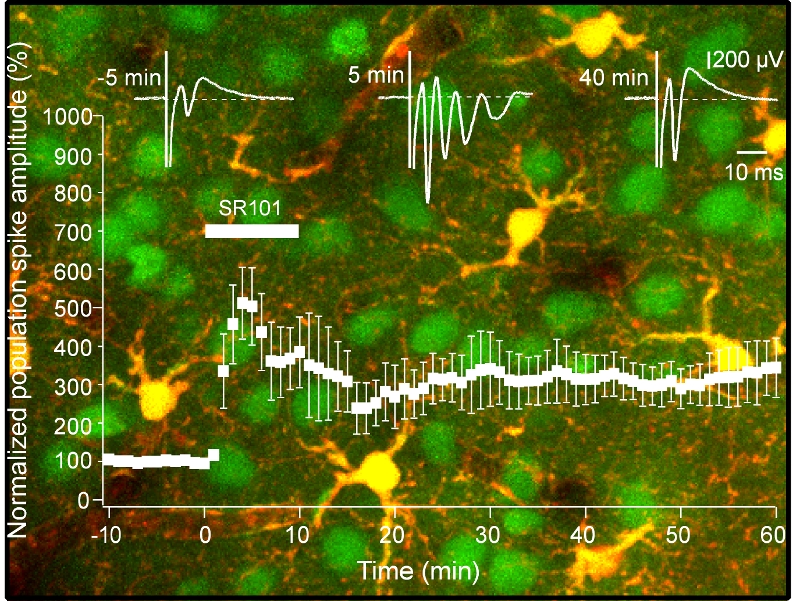Imaging microcircuit function in healthy and diseased brain
 SR101 turned out to be a highly bioactive molecule. When tested in acutely prepared hippocampal slices this substance markedly increased the excitability of neuronal tissue (Fig. 1B-F, (Fink et al., 2011)). Bath application of SR101 induced a 5-6 fold increase in the amplitude of a synaptically-evoked population spike caused by the stimulation of Schaffer collaterals and provoked a synchronized repetitive firing of neurons at a frequency of 130-200 Hz. The SR101-evoked hyperexcitability developed rapidly (the maximal effect was reached during the first 5 min of drug application) and persisted for at least 40-60 min after the wash-out of the drug. Field EPSPs recorded in the stratum radiatum of the CA1 region also underwent long lasting potentiation. Thus, in the hippocampus SR101 works like other drugs inducing chemical LTP. It causes long-lasting changes in neuronal excitability and the efficiency of excitatory synaptic transmission. When tested in vivo SR101 induced epileptic seizures in the hippocampus (Kang et al., 2010).
SR101 turned out to be a highly bioactive molecule. When tested in acutely prepared hippocampal slices this substance markedly increased the excitability of neuronal tissue (Fig. 1B-F, (Fink et al., 2011)). Bath application of SR101 induced a 5-6 fold increase in the amplitude of a synaptically-evoked population spike caused by the stimulation of Schaffer collaterals and provoked a synchronized repetitive firing of neurons at a frequency of 130-200 Hz. The SR101-evoked hyperexcitability developed rapidly (the maximal effect was reached during the first 5 min of drug application) and persisted for at least 40-60 min after the wash-out of the drug. Field EPSPs recorded in the stratum radiatum of the CA1 region also underwent long lasting potentiation. Thus, in the hippocampus SR101 works like other drugs inducing chemical LTP. It causes long-lasting changes in neuronal excitability and the efficiency of excitatory synaptic transmission. When tested in vivo SR101 induced epileptic seizures in the hippocampus (Kang et al., 2010).
http://www.sciencedirect.com/science/article/pii/S0014488612000684
- 63 views
